Genre: Platform Developer: Data East Publisher: Data East Players: 1-2 Released: 1993
I hate Jenny. I don’t see what Will and Rick see in her. Sure she’s a blonde sprite with large breasts, but she’s so selfish and demanding. “Give me ten jewels!” “Give me a present! Bring it here!” While any sane person would either slap her silly or ignore her whiny demands, the two “cowdudes” are ready and willing to toss aside their friendship to fight over here. Jenny needs to go to damsel in distress school, because henpecking your hero is not the way to encourage success.
Will and Rick are the stars of two Data East games released in 1993: Dashin’ Desperadoes for the Sega Genesis and Spin Master for the Neo Geo. Yet, aside from the two lead character designs, these are completely different games. In fact, they are so different that Will, Rick, and Jenny go by Tom, Johnny, and Mary in Spin Master. It’s an odd move on the developer’s part as is the decision to release a standard platformer for the arcade but a two-player competitive game for a home system.
Dashin’ Desperadoes is a competitive split-screen platform race around the world. It seems Jenny’s father has given her vacation to six distinct spots all over the globe carrying the unique names of Town, Wilderness, Ocean, Jungle, Iceberg, and Ruins. Will and Rick chase after her, with Jenny taunting them both along the way. Each spot has three levels; most stages are designed as an obstacle course to the end where Jenny sadistically waits, but every third stage poses a different challenge. In the single player mode, you’ll fight your rival as he attempts to kidnap Jenny in a truck, plane, or blimp. When playing against another person, the third stage either involves Jenny making some demand to retrieve items for her or having to defeat some third party at her request.
Each course will generally have two paths, typically with the higher, more difficult to reach route being faster and with fewer obstacles. Along the way you’ll encounter monkeys, sharks, dogs, birds, and other creatures out to knock some sense into Will and Rick. Each time a character is hit by an enemy, he stumbles and is delayed. While you can hop on most enemies for points, the chief concern is to make it to the end as fast as possible to both beat the opponent and earn the time bonus. While there is a timer and enemies in the game, neither will result in a game over — the game only ends when one of the cowdudes reach Jenny.
Though the characters are invincible, being delayed is a big penalty for what is essentially a racing game. Will and Rick aren’t super heroes — they’ll trip over skateboards and shudder when falling from great heights. With the split-screen only showing so much of the level, the large character sprites (relative to the viewable window), and plethora of obstacles, Dashin’ Desperadoes really requires memorization to do well. Learning the shortcuts and enemy locations is vital to making good time and beating your opponent to Jenny. Knowing that you should roll under a penguin since it’ll leap when you approach, for instance, will shave seconds off your time and keep you ahead of the game.
Of course, Will and Rick have some moves to help them succeed in each race and impede the competition. Not only can you activate some background traps to interfere with the other player such as jumping on and triggering a fire hydrant to spout water, but you also have access to an infinite supply of bombs. Bombs are short-ranged weapons thrown at an arc which will stun an opponent on impact. The bombs in the game have five power up upgrades available but can only be used on your opponent; stage enemies are unaffected by bombs, as animals in games are typically more susceptible to stomps on the head and back than they are to normally dangerous explosives.
Once a player has the lead, the game will usually try to help out the person trailing behind by releasing a power-up to help challenge the lead. There are Speed Boots which act as a turbo boost, Invisible Potions with grant both a speed-up boost and hide your character from the other screen, and a Honeycomb and Thundercloud which release flying obstacles that will track down the opponent and stun him for a bit. You can also grab a Power Chicken to restore your roll meter (rolling is faster than running but is limited to a slowly recharging gauge) to make up lost time. These power-ups help make the game exciting to the end, as it would be difficult to continue playing a racing game once you’ve lost the lead by a good margin.
Still, while this sort of forced rubberbanding make for a fun two-player competition, it absolutely stinks in the single player mode. Nothing is more infuriating then nailing the computer controlled Rick with a bomb, taking a considerable lead, and then having him rocket out of nowhere and stun you at the last second before you can reach Jenny. Dashin’ Desperadoes is very much a two-player game with a single player mode tacked on a la ToeJam & Earl, and racing against a computer just isn’t fun. With only eighteen short stages and little depth other than completely memorizing the layout of each level, it’s difficult to recommend Dashin’ Desperadoes to anyone without someone to play against.
For those with friends, though, Dashin’ Desperadoes is a fun, chaotic trip that’s worth a look. The graphics are bright and colorful with quite a bit of detail packed into the levels. Will and Rick are very expressive and wail when struck, look pained when hitting the ground hard, flatten when crushed, and even have a teetering edge animation a la Sonic even though you’ll never see it in practice since you’ll be too busy racing ahead. The levels look clean and carry a unique theme and time setting to make things interesting both to play and look at. Everything animates decently, and there’s not a hint of slowdown which is pretty impressive given the split-screen and number and size of the sprites. I suppose the flat single scrolling backgrounds takes the bullet here, since the only parallax scrolling to be found is in the title and ending, but it’s not something to be missed during gameplay.
The in-game music is expectedly Western tinged with an arcade flair, and it makes for a decent enough background soundtrack. If you do as the developer surely intended though and stick a friend in Rick’s shoes, then you’ll be too busy yelling and cursing each other out to even bother listening to it. As with any multi-player game, having friends to play with increase the fun factor far more than a computer opponent can, and, sure enough, the game ends with Will and Rick ditching Jenny to be friends again (and that’s platonic friends… no Brokeback Mountain relationships here, though it would have made for an interesting tie-in). Will and Rick or Tom and Johnny went through their fifteen minutes of video game fame about as quickly as it takes to beat their games, and it’s too bad because both of them are pretty good for what they are.
SCORE: 7 out of 10


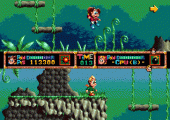
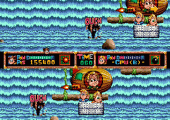
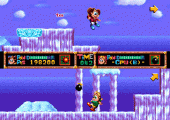
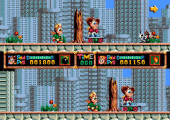
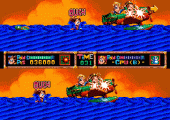
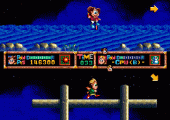
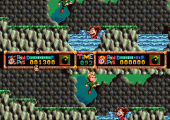
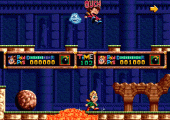
A very good game with tight controls and frantic rythm. The one player mode is fun, and with a friend it can become insanely fun. Highly recommended, and much better than you’d expect by looking at the horrible cover. I agree with Greg on this one and give it an 8.
This is one game you’d never expect to be any good just from looking at it (especially if you judge by the box art), but then you play the thing and it turns out to be surprisingly fun! Overall the gameplay is frantic and exciting, and lives up the the Genesis’ reputation for speed. Controls are tight and responsive, graphics are pleasant with a nice colour palette and the levels are nicely laid out. This game plays a lot like a Sonic title with just enough innovative content that it can’t really be called a Sonic clone. It’s a great 2 player title, but single player mode is also quite enjoyable. Overall this is a great game that is far too often overlooked. 8/10